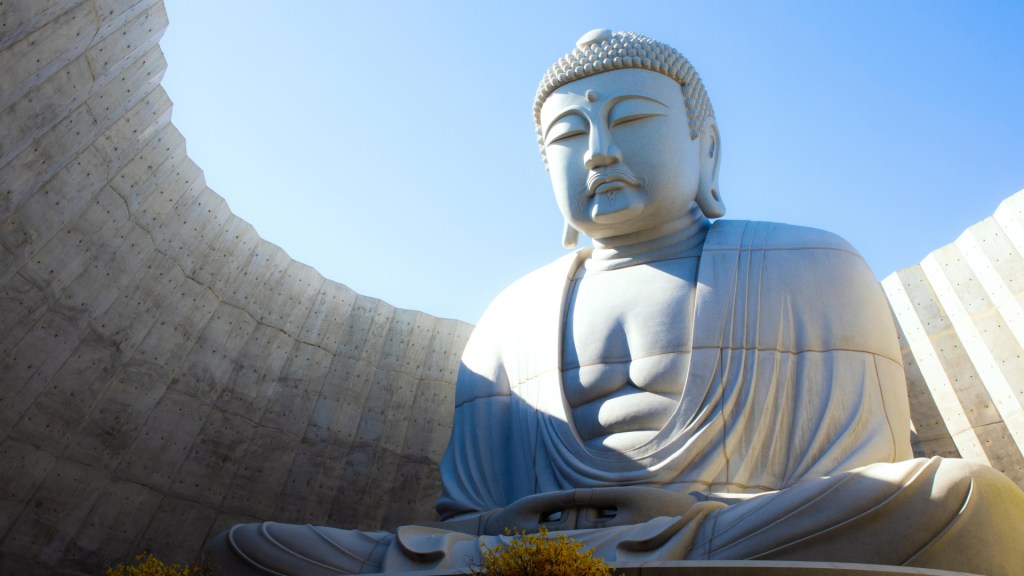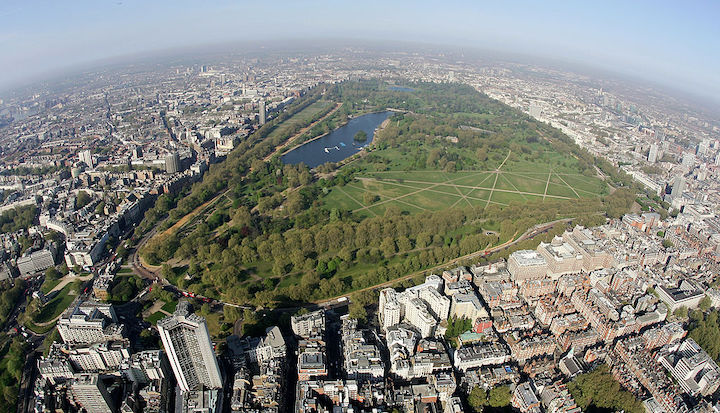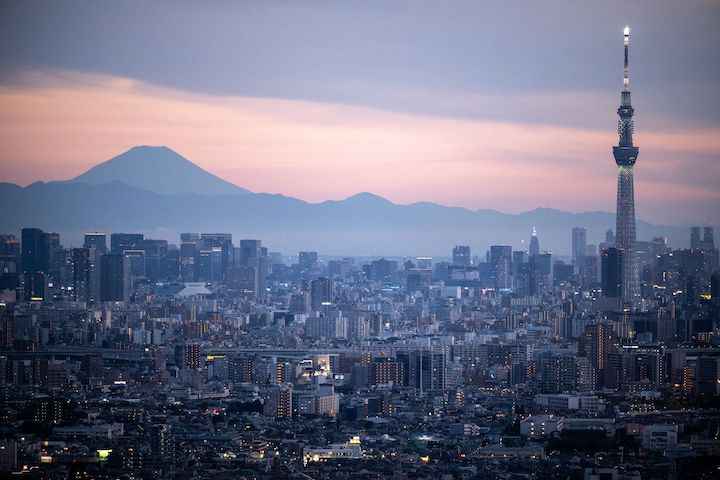There are three things that occur to you when you travel the length of Japan: that kimonos are surprisingly good for any occasion; that the country’s reputation for cruelty may partly derive from breakfasts comprising tea porridge and prawn soufflé; and that the hordes of camera-wielding Japanese tourists taking thousands of snaps – a comic trope in the 1980s, at least – were really just ahead of their time and the rest of us are only now catching up thanks to our iPhones.
First impressions of Tokyo might persuade you that you’ve accidentally fallen into a dystopian future: the march of skyscrapers and mesh of streets sprawls greyly on for the best part of 100 miles
Of course, in some ways Japan is the perfect society: the standards of honesty are such that they’ll chase you down if you leave six yen (2p) in change behind in a convenience store and you can set your watch by the buses, let alone the trains. I was delighted by the lack of tipping, too. But first impressions of Tokyo might persuade you that you’ve accidentally fallen into a dystopian future: it’s a place where snub-nosed locomotives slice through the suburbs at all hours, where neon-lit back-alleys offer incomprehensible services and where the march of skyscrapers and a mesh of streets as intractable as the telephone wires sprawls greyly on for the best part of 100 miles. This, after all, is the world’s largest metropolis, with a population of nearly 38 million.
But we’re here to talk about architecture, not maid cafes, Sapporo beer or fried octopus balls – and there’s a lot to talk about. In recent years, Japanese architects have come to dominate the scene: Kengo Kuma built the V&A Dundee, Shigeru Ban the Aspen Art Museum, Toyo Ito had a crack at the Serpentine Pavilion in Hyde Park, and Tadao Ando breathed new life (and a lot of cement) into the Bourse de Commerce in Paris and the Punta Della Dogana in Venice. For a while, if you wanted to win the Pritzker – architecture’s biggest prize – it looked like you had to be born Japanese.
But here in the UK we know a thing or two about buildings, too. So, in the spirit of a frank cultural exchange of the sort that inspired Charles Rennie Mackintosh to create cherrywood-lined Glasgow tearooms, here are five things each country can learn from the other…
1. Tradition
Bit obvious, right? The Japanese like wood, boy do they like wood. Hence the Olympic Stadium by Kengo Kuma, which has a roof made of larch and cedar. And Shigeru Ban works mostly with paper and cardboard. And the craftsmanship is impeccable. Actually, it goes far deeper than that: simplicity, honesty and purity have always been Japanese architecture’s guiding principles, and you can see that in their modernist architecture too. It’s a tradition that is constantly reinvented – how’s that for a Zen-like riddle (known as a Kōan)?
2. Ambition
This is the country that built a network of 300mph Shinkasen, or bullet trains, before the 1964 Olympics. We’re still trying to connect Birmingham and London. Nothing is impossible: for example the 634m Tokyo Skytree, the second tallest building in the world (featured in the image at the top of this article), and the 325m A District Tower, the second-tallest in Tokyo, are both designed to be completely impervious to earthquakes, such as Great Kanto Earthquake, which killed 140,000 people in 1923. This is achieved in part due to ‘motion dampers’ – heavy pendulums that sway counter to the motion induced by the earth moving – and base isolation: effectively sitting everything on a rubber base. And then there’s the bridges, such as the Great Seto, the world’s longest two-tiered span. Meanwhile, the latest news on HS2 is that it may stop short of Euston to save money.

3. Experimentation
Perhaps because of the history of earthquakes and other natural disasters – fire being a particular threat to the old wooden houses – architecture, as with so much of life, is considered to be transient. The average lifespan of a house in Tokyo, for instance, is thought to be about 25 to 30 years. This brings great freedom (after all, if you make a mistake it’s not forever) and may help to explain some of the most exuberant architecture on the planet: not least the fashion houses of Omotesando, like the lattice concrete of Tod’s by Toyo Ito, and Prada by Herzog and de Meuron, with its diamond bubbles of glass. It’s amazing what you can achieve when you’re not tied to a long-lasting structure.
4. In-filling
Japan has more architects per capita than anywhere else, and most of them work on smaller domestic projects, producing houses that are unique, innovative and often designed to fill a small slot of land within the existing cityscape – on infill and brownfield sites. Squeezing another house in where land prices are high is obviously a far better idea than covering acres of precious greenbelt land with Wimpey boxes, and again produces some highly distinctive residences – some good, some bad, most tiny. It’s an idea that’s unlikely to catch on here, though.
5. Surprise
Ihyou, a sense of novelty or the unexpected, is an important part of Japanese architecture and can be achieved in unusual ways. Tadao Ando decision, at his Hill of the Buddha prayer hall, to bury a Buddha statue under a hill of lavender with only the top of his head showing is perhaps the ultimate example of this. Ando’s Chichu Art Museum in Naoshima also plays with this idea, using a series of courtyards and skylights to illuminate subterranean galleries. His ability to bring a lightness to heavy materials is one of the reasons he’s so popular in the West too.

And yet, Japanese cities are rarely beautiful. So much was thrown up so quickly after the devastation of the second world war, of course, but it’s fair to say there are things that we do better in the UK:
1. Legibility
If you go to London Bridge Station, newly reforged by Grimshaw, you can immediately identify where the platforms are, where the shops are, where the information booth is. It’s legible. This is often a quality missing in Japan – follow the signs for the Metro down a hole in Tokyo and you’ll be lucky to escape the inevitable shopping centre in under half an hour. Tokyo station and Kyoto station are virtually unnavigable once inside. I once asked for directions to a platform at Kyoto, which was about 100 metres away. It involved the poor Japan Rail representative having to produce a 3D diagram.
2. Green space
In Japanese cities there’s a real lack of it, bar the perimeters of one or two central palaces (needed as emergency assembly points). Few small parks, few tree-lined boulevards, no piazzas, no big squares – and the formal gardens of Samurai times are gated and ticketed. You realise just how green places like London are. And in the absence of a protected greenbelt, the cities are seemingly endless: Kyoto blurs into Osaka, Tokyo into Yokohama, and the whole Pacific coast looks like one grey carpet from the plane.

3. Brick
Who said that a man that’s tired of concrete is tired of life? Well, in Japan, there’s a lot of it. It doesn’t help that nearly 50 per cent of the country’s 22,000 miles of coastline is covered with Tetrapods – the four-legged concrete blocks that, Canute-like, hurl back the waves. There are slightly questionable environmental and economic reasons for this – and heck, you can even get cuddly toy versions now – but it’s not the same stretches of sand. The concrete streetscapes have you longing for a bit of red brick too. Or a pale yellow Cotswold one – lovely.
4. Preservation
After the American bombers there wasn’t necessarily much left. But until recently the preservation of old buildings wasn’t something that many Japanese people attached much importance to (see the bit about the 25-year lifespan of houses). Gazing down on the centre of Kyoto from the hideous Kyoto Tower prompts you to wonder just how such a horrible urban environment could have sprung from the ancient capital – which famously wasn’t bombed because the US Secretary of War, Henry L. Stimson, had been on his honeymoon there and ordered it to be spared. We’ve had our problems – and it may be no consolation to the Euston Arch – but have done much better. The wonderful restoration of Tokyo Station is a welcome sign that attitudes are shifting, though. Just don’t venture inside.

5. Space
The British might have plenty of stories about student digs where the bed is in the bath, or vastly overpriced apartments where you can fry an egg while in the shower, but overall we have much more sizeable properties to potter around while waiting for an Amazon delivery to arrive. According to the Japanese government, in 2019 the average floor space of an apartment in Tokyo was approximately 66 sq m – with 41 sq m usable as living space. In London it’s about 78 sq m, though this increases the further you move out. Across England and Wales the median was a luxurious 99 sq m. Space – truly the final frontier.
But above all, cross-pollination is a wonderful thing. What else could we learn from each other?






Comments